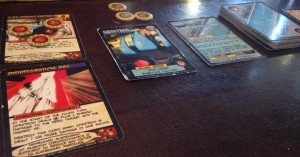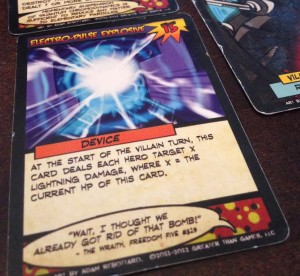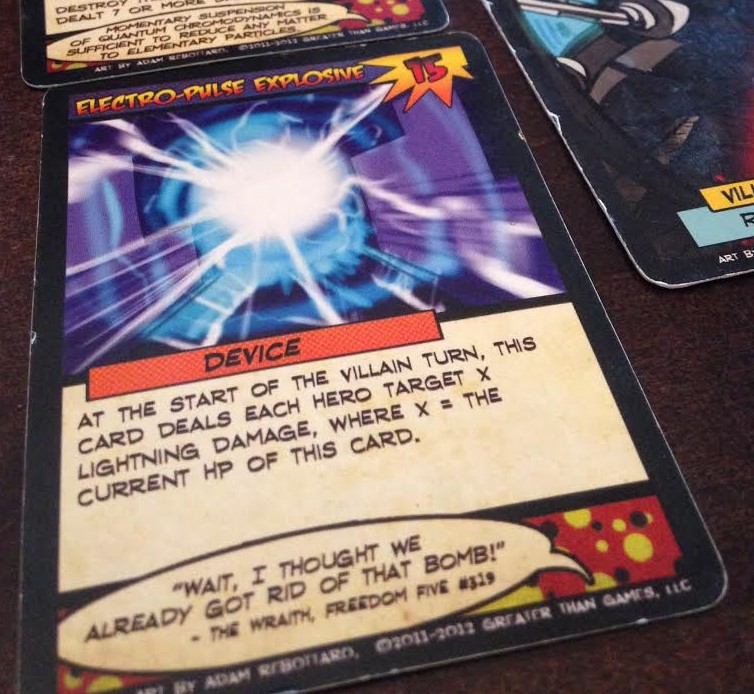This week’s Monday Night Gaming: Sentinels of the Multiverse.
Publisher: Greater than Games
# of Players: 1-5 players
Best with: 4 players
Playing Time: Depends on the # of players. While the box says 30-60 minutes, in a 2-player first run-through, it was almost a two-hour game for us.
# of Expansions: Five, plus lots of promo cards
# of Parts: 578 cards.
 You know me–I love deck builders. I love Legendary from the Marvel universe, so it wasn’t outside the realm of possibility for me to enjoy this game…except that with two players, the game is incredibly unbalanced and clunky. For a cooperative, fixed-deck game, this should have been a fun play.
You know me–I love deck builders. I love Legendary from the Marvel universe, so it wasn’t outside the realm of possibility for me to enjoy this game…except that with two players, the game is incredibly unbalanced and clunky. For a cooperative, fixed-deck game, this should have been a fun play.
General Mechanics: This game is a cooperative game that unlike many deck builders, begins with a fixed-deck, meaning each player begins with a pre-made deck of forty cards, based on the heroes chosen (there are ten total to chose from). The game consists of three stages within one round:
- The villain’s turn
- The players’ turns
- The environment’s turn
Each players battle together against one of four villains and sometimes the environment. At the start of the villain’s turn, players play the top card from the villain deck and follow the instructions on the card. This could be anything from straight damage to the players to turning over additional cards and following their instructions.
Players then will take turns playing a card from their hand (which can damage 1 or more enemies or grand powers) and using a power in play. Then they draw a card from their deck. The idea is to use these powers to increase the amount of power done to villains and decrease the damage taken from villains. Some powers allow the players to heal or use other boons.
Environments are played like villains in that players turn over a card and follow the instructions written on it. Sometimes environment cards help the villain, and sometimes they help the players. An environment card could force players to not draw any cards or not use powers in play, or they might increase damage dealt per round to the villain.
Each villain has advantages and quirks that make defeating him/her more interesting. Players continue cycling these rounds until the villain is reduced to 0 HP and defeated. Or until the villain defeats the heroes.
Each villain has various advantages, such as starting with certain cards in play, as specified by the villain character card. Play continues until the heroes reduce the villain to 0 or fewer HP, or until the villain defeats the heroes, either via a win condition or by reducing all the heroes to 0 or fewer HP.
How to Win/Lose: The game is over when either the players reduce the villain to 0 or fewer HP, or if the villain defeats all the heroes, either by reducing them all to 0 or fewer HP or by some other win condition.
What I Liked: Having a cooperative game against a villain was pretty neat for a deck builder. I enjoyed the idea of the three rotations (villain, players, environment), at least I did once I got used to it.
What I Didn’t Like: It’s possible that this game plays incredibly different in a four player game, but with two players, it was nearly impossible to keep up with the villain’s damage. A few rounds in, we were both down to 8 health left with little way to heal. And then this card came into play:

It reads: At the start of the villain turn, this card deals each hero target x lightning damage, where x = the current HP of this card (which at the beginning is 15).
There’s a mechanic throughout the game called H, which is equal to the number of players. The purpose of H is to allow the game to scale with the number of players. The card above doesn’t scale. At all.
So the first five rounds had us yo-yo-ing between 20-30 HP each. Round seven, we got walloped with a massive villain + environmental attack, which took us both down to 8 HP and left us unable to use any powers (that means no healing). We drew this card on round eight with no way to shut it down. We managed to damage the card and bring its HP down to 12, but at the beginning of round nine, it hit us both for 12 points each. We were immediately and irreversibly dead.
I understand that this is a game where we might not beat the villain, and that’s fine, but to have a game ending card like this that doesn’t scale alongside the rest of the game is hitting below the belt. It soured the game for both us and made us ask, why bother?
If you’re going to make a balanced game, make it balanced. Ditch mechanics and/or cards that halt the game (and the fun) so easily.
Overall Rating/Impression: 3.0/10.0. I don’t often give a game so low a score on a first run through, but this was pretty disappointing.



That Omnitron card is very nasty, but not necessarily a game ender. Visionary and Wraith with her eyepiece can mess with his deck, Visionary and Tempest have cards that are great for that card, Fanatic has some options (at a cost, I believe) and somebody like Tachyon or Haka can do a ton of damage singlehandedly. (I love, love, love playing Tachyon…I did the full 22 damage with Lightspeed Barrage with her once. I usually end up having to use that card when I have 12-17 in her trash, but I had all but one card in my trash that day and it was glorious!!! I hit with one of her other one shots for a couple of points, then mega Lightspeed Barrage! BAM! With some bonuses from another hero, I did 27 damage that turn total. Closest I’ve gotten to that with another hero is 25 in one turn.) Omnitron really only has a small number of cards in his deck that, under the right circumstances (certain environments, for example, or with a team that isn’t diverse…or just bad timing) can significantly hurt the heroes. First time we played him, he handed our asses to us, but once you figure him out in regular play (which doesn’t take long) and get a feel for how to strategize with various heroes, he’s not bad at all.
Main thing I’m not clear on is whether you guys were trying to play with 2 heroes. That’d make him pretty effing ridiculous. I don’t have the rules from the box on hand to say that it’s very clear there, but I believe the official suggestion for 2 player games is to still use 3 or 4 heroes. That’s what the site says under Hero Selection and that’s how Nate and I play when it’s just us. We typically do 2 heroes a piece, but we’ve done games where one of us does 1 and the other does 2. We’ve played tons of 3 player games over the years with friends, too. 3-5 heroes is challenging and allows you to have a diverse enough team to win fairly regularly. It’s still a hard game, of course. Which is, naturally, all part of the fun!!
But there are some villains that do things that are waaaaaay more frustrating than Omnitron–they’re not unbeatable, but different heroes, different teams interact with different villains differently and environments can interact with the villain to make things 8000 times harder (or really easy, if certain heroes get the right things out). Even in the base set, that stupid Mars base destruct button has ended many a game! And I know how to run a really good game with Absolute Zero or Bunker at this point, but sometimes you just can’t get set up. It’s what’s leant the game to so much replayability for us. I do crazy things like play Unity and Argent Adept at once against somebody with a zillion minions…or the Omnitron inception game. Omnitron vs Omnitron X (plus other heroes) in the Omnitron environment. We need an Omnitron soundtrack for that. It’s crazytown.
In the base set, I found Tempest, Wraith, and Tachyon to be the easiest to figure out and get going quickly. I love Absolute Zero, but he can be challenging. Legacy is perhaps my least favorite character in the whole game (including expansions) to play, because he is pretty much support, but he’s great to have on a team of 4 or 5. I don’t have the patience to play Bunker most of the time (because while he sets up, it doesn’t feel like he is doing much unless he grenades the environment), but Nate loves Bunker and has a strategy for him that kicks much butt. Each hero, villain, and environment feel extremely different and I think it reinforces the theme. I’m big on theme for games. The expansions have been great.
Anyway, I could blather on and on about it. Haven’t tried Marvel Legendary, because it looks so mix and match. Like, if I’m gonna be in that universe, I wanna be one hero in that universe with all his/her strengths and shortcomings and play with people who are being other specific heroes and not mixing up Hulk smash with Mjolnir. (Probably why Sentinels went over well with me!) I’m willing to give it a go, but not sure if it’ll be my thing.
MeriSand The particular edition we checked out from Mox did not suggest 3-4 heroes. That would have made a world of difference.
Deck builders are my favorites, but I don’t like games where I have to magically know to play certain heroes against certain bosses or else X card combo kills the game. That’s bad design imho.
We’ve played games that were like that (Dominion, which is my FAVORITE deck builder), but usually the instructions introduce you to the game with a “play with these heroes and this villain” combo or whatnot until you understand the mechanics enough to feel like branching out.
That two card combo was a total cock-block and not fun. :/
MeriSand Case in point–the H concept exists to scale the game with the number of players. It’s supposed to make up for 2 players so that we don’t have to play 4 heroes.
Also, those 2 rounds, we weren’t allowed to play any cards at all due to an environment card. If you can’t play any cards, you can’t counter the nasty card on the table. Game over. :/
MeriSand Ah, found it. In the “Enhanced Edition,” which has a different rulebook, they stuck this under ADVANCED PLAY:
“Additionally, two experienced players can play Sentinels if one or both of them play as two heroes each.”
So despite the H scaling mechanic and a box that said playable by 2-6 players, their own rulebook basically comes out and states that 2 player games are for advanced players only and that the game is so unbalanced they had to add this addendum. This sort of knowledge is something that should have been on the front page of the instructions, not tucked into a paragraph on advanced play on page 14/24 in an enhanced edition rulebook.
kaonevar MeriSand I’m just talking about what it says on their main webpage under gameplay on hero selection (page 2), which is not any kind of advanced thing. They totally should make that clear on/in the boxes if it isn’t, because the game doesn’t scale below 3 heroes and even solo players play 3 or more heroes.
http://sentinelsofthemultiverse.com/gameplay
They probably should also suggest Baron Blade as the villain to try in the 1st game (or even a few games, to try out different heroes and environments). That’s what I would do if I were them. When the company created this game, it was apparently just 3 people and it was their first game. It went out of print and they released a 2nd updated edition that took care of problems with the first run of the game. That’s the “Enhanced” edition Nate and I got a few years back. The documentation could totally use work, but given that their relative newness and smallness (having to kickstart expansions, etc), I think they’ve done a decent job. Perhaps a future edition will have better documentation in the box.
I hope you know I’m not suggesting that I expect anyone to have to play a ton or magically know who to play against who in order to have a good game. I personally have yet to find a scenario that is completely unwinnable or something, just that each deck plays radically differently from other decks and they interact with each other in some cool ways that make the game interesting to Nate, myself, and other people who have played with us. But there have been a few people who didn’t like the game. Mostly because there can be a lot to keep track of.
And I empathize with your crappy experience. I know what it’s like to have a crappy time with a game. It sucks. My first Dominion games were with a bunch of expansions all mixed together and people were using attack cards. I had no experience with any table top games except Pandemic and Munchkin, maybe Fluxx or Hive. I was toast. I died a pauper over and over. (At least that’s how I interpreted scoring so poorly.) It took me awhile to catch on like that and it was very frustrating for awhile. And Puerto Rico, which I fucking swore to never touch again, because fuck that. And, now, I kinda wanna try Puerto Rico again. Because it felt so impossible. I have to know if it’s just me or if it was just *that* game that particular day. And someday, I will be unlucky enough to be the traitor in Betrayal in the House on the Hill and I will hate every minute of it. I’ve just been lucky so far. But crappy game time sucks.
It sucks that you didn’t find it enjoyable, but different strokes for different folks. That’s totally fine. I just babble because it’s my favorite game and I love to geek out over it, with Ghost Stories as a close second. (Talk about a game that you have to basically go get instructions from the internet, though–whoever translated the instructions for Ghost Stories was on some kind of ethereal crack…and talk about freaking hard as fuck!! I still have no idea how anyone plays in Nightmare mode. No clue. I think it’s impossible.)
MeriSand Oh, I know. It’s all good. 🙂 Dominion is my favorite deck builder, and yeah, you have to start with the intro rules (which are in the manual in the box) if you’ve never played a deck builder before. 🙂 I haven’t tried Ghost Stories yet. 😉